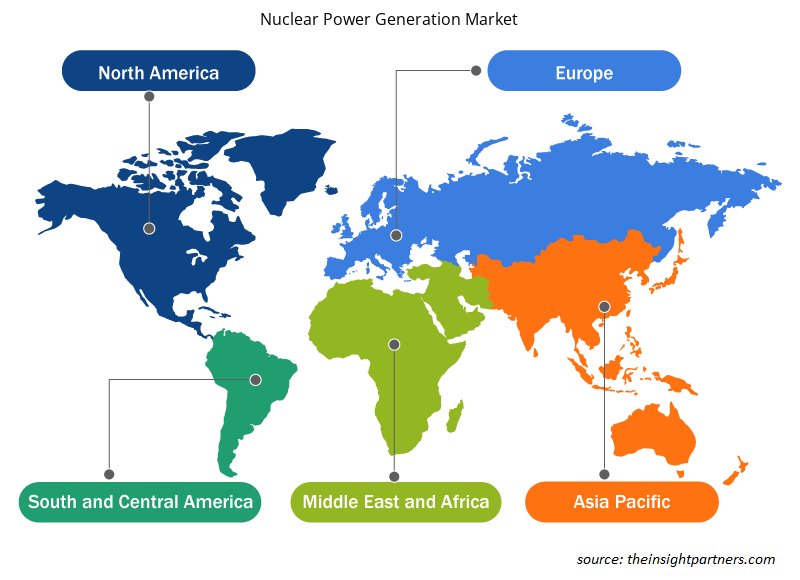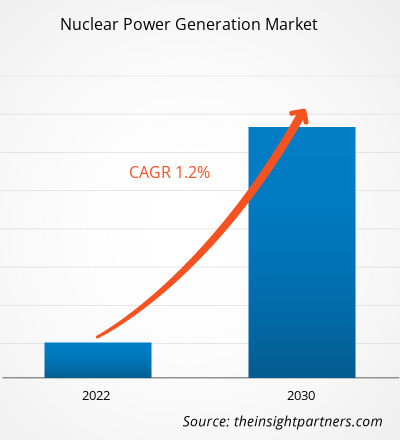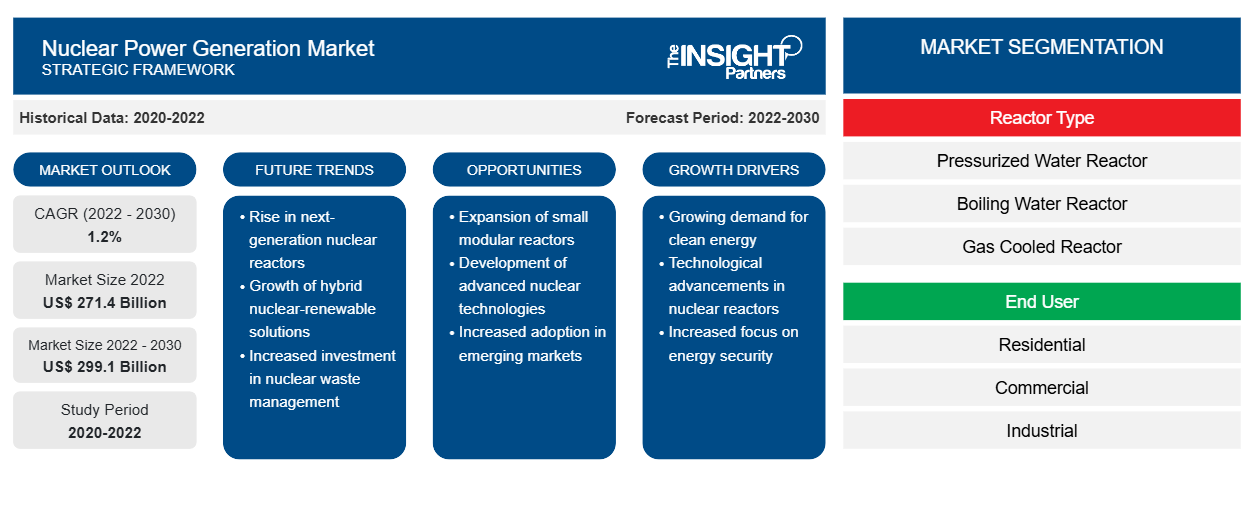[Rapporto di ricerca] Si prevede che il mercato della generazione di energia nucleare raggiungerà i 299,1 miliardi di dollari entro il 2030, rispetto ai 271,4 miliardi di dollari del 2022; si prevede che il mercato registrerà un CAGR dell'1,2% nel periodo 2022-2030.
Prospettiva dell'analista:
È probabile che le tendenze del mercato della generazione di energia nucleare forniscano nuove soluzioni per soddisfare la domanda alle stelle di elettricità. La crescente domanda di energia e la crescente attenzione alla transizione energetica verso alternative pulite dovrebbero aumentare la necessità di centrali nucleari durante il periodo di previsione. La domanda di energia in tutto il mondo sta aumentando a causa delle esplosioni demografiche e della crescente industrializzazione. Vari paesi stanno cercando fonti di energia diversificate e affidabili per ridurre la loro dipendenza dai combustibili fossili e garantire un approvvigionamento energetico stabile. Pertanto, si prevede che l'aumento della domanda di elettricità pulita, insieme agli obiettivi di riduzione delle emissioni di carbonio da parte dei governi di tutto il mondo, alimenterà la crescita del mercato della generazione di energia nucleare dal 2022 al 2030.
Panoramica del mercato:
Il rapporto sul mercato della produzione di energia nucleare include una valutazione delle prestazioni del mercato nelle diverse regioni.Con la crescita dell'industria nucleare negli ultimi anni in regioni come Nord America, Europa e Asia Pacifico, anche la domanda di generazione di energia nucleare è in aumento. Attualmente, Stati Uniti, Canada, Francia, Russia, Cina, Corea del Sud, Sudafrica e Brasile sono i principali mercati per la generazione di energia nucleare. Poiché vi è la necessità di sicurezza energetica e sostenibilità, l'energia nucleare è favorita. Fornisce una fonte di energia costante e costante, meno vulnerabile alle fluttuazioni dei prezzi e alle interruzioni di fornitura rispetto ai combustibili fossili. Inoltre, le nazioni hanno bisogno di varie fonti di energia affidabili per ridurre la loro dipendenza dai combustibili fossili. Questi fattori stanno aumentando il mercato della generazione di energia nucleare.
Personalizza questo report in base alle tue esigenze
Riceverai la personalizzazione gratuita di qualsiasi report, comprese parti di questo report, o analisi a livello nazionale, pacchetto dati Excel, oltre a usufruire di grandi offerte e sconti per start-up e università
-
Scopri le principali tendenze di mercato in questo rapporto.Questo campione GRATUITO includerà analisi di dati che spaziano dalle tendenze di mercato alle stime e alle previsioni.
Fattore trainante del mercato:
Crescente numero di centrali nucleari
L'evoluzione della domanda di energia a livello globale, spinta dalla crescita della popolazione e dall'industrializzazione, richiede lo sviluppo della produzione di energia, che, a sua volta, dovrebbe guidare le dimensioni del mercato della generazione di energia nucleare dal 2022 al 2030. L'energia nucleare può offrire una parte sostanziale dell'elettricità necessaria per supportare la crescente domanda di energia. Inoltre, la sicurezza energetica è una delle ragioni principali che influenzano l'evoluzione globale dell'energia nucleare. I paesi si stanno concentrando principalmente sull'aumento della quota di risorse energetiche diversificate e affidabili per ridurre la loro dipendenza dai combustibili fossili, garantendo un approvvigionamento energetico stabile per la crescita economica e la sicurezza energetica nazionale. Secondo la World Nuclear Association, circa 440 reattori nucleari sono operativi in 32 paesi, con una capacità combinata di circa 390 GWe . Nel 2022, i reattori nucleari hanno fornito 2.545 TWh , che rappresentano circa il 10% circa dell'elettricità globale. Circa 60 reattori sono in costruzione a livello globale e 110 sono previsti nei prossimi anni.
Analisi segmentale:
In base al tipo di reattore, il mercato della generazione di energia nucleare è segmentato in reattori ad acqua pressurizzata, reattori ad acqua bollente , reattori raffreddati a gas e altri. Il segmento dei reattori ad acqua pressurizzata ha rappresentato la quota di mercato più grande nella generazione di energia nucleare. Ha rappresentato l'80,5% del mercato totale nel 2022 e si prevede che manterrà il suo predominio durante il periodo di previsione. I reattori ad acqua pressurizzata (PWR) sono il tipo più comune, che utilizza acqua pressurizzata per il raffreddamento e la moderazione dei neutroni. Cina, India, Stati Uniti, Francia, Brasile, Canada e Russia sono tra le principali economie con un'elevata installazione di PWR. I PWR rappresentano uno dei progetti di reattori nucleari più diffusi a livello globale. I reattori ad acqua bollente (BWR) utilizzano anche l'acqua ma le consentono di bollire direttamente, generando vapore per l'elettricità.
Sia i PWR che i BWR sono ampiamente utilizzati per le loro caratteristiche di efficienza e sicurezza. I reattori raffreddati a gas (GCR), come i reattori raffreddati a gas ad alta temperatura (HTGR), impiegano elio e altri gas come refrigeranti. Questi reattori raffreddati a gas operano ad alte temperature e hanno varie applicazioni oltre all'elettricità, tra cui la produzione di idrogeno e i processi industriali. Altri tipi di reattori includono i reattori autofertilizzanti veloci, i reattori ad acqua leggera e grafite e i reattori a neutroni veloci.
Analisi regionale:
Secondo le stime di The Insight Partners presentate nel report di mercato sulla generazione di energia nucleare, l'Europa deteneva il 44,9% della quota di mercato nel 2022 e si prevede che registrerà un CAGR del -2,9% durante il periodo di previsione. Il calo del tasso di crescita della regione europea è dovuto alla chiusura delle centrali nucleari. Tuttavia, alcuni paesi in Europa sono impegnati nell'adozione di strategie chiave per obiettivi di riduzione del carbonio e sicurezza energetica dalla generazione nucleare. Per soddisfare gli obiettivi di riduzione delle emissioni di carbonio per il 2050, molti paesi nella regione si stanno muovendo verso la generazione e l'utilizzo di energia a basse emissioni di carbonio. La Francia è uno dei principali paesi nel mercato europeo della generazione di energia nucleare, con una quota totale di oltre il 29,7% nel 2022. Si stima che l'aumento della domanda di generazione di energia pulita e la crescente necessità di sicurezza energetica nel paese guideranno la crescita del mercato nei prossimi anni.
La crescente attenzione alla sicurezza energetica e i crescenti casi di instabilità geopolitica stanno aumentando la domanda di energia nucleare in Europa. La produzione di energia nucleare in Europa ha rappresentato 939,2 TWh nel 2022. La Francia produce elettricità da 58 reattori nucleari ad acqua pressurizzata. Ha generato 297 TWh di elettricità da centrali nucleari, che rappresentano oltre il 65% dell'elettricità totale generata nel paese nel 2022. Si prevede che la crescente attenzione alle iniziative per ridurre le emissioni di carbonio e rafforzare l'obiettivo del paese verso la transizione energetica tramite alternative sostenibili porterà tendenze nel mercato della produzione di energia nucleare. Oltre all'Europa, anche il Nord America e l'Asia Pacifica sono tra le regioni chiave per il mercato in esame. Il Nord America e l'Asia Pacifica hanno rappresentato rispettivamente il 29,3% e il 21,6% della quota di mercato totale della produzione di energia nucleare nel 2022. Cina, Corea del Sud, Giappone e India sono i principali mercati dell'Asia Pacifica. Gli Stati Uniti hanno dominato il mercato della produzione di energia nucleare in Nord America. La capacità di fornitura energetica a lungo termine delle centrali nucleari e i progetti avanzati di reattori offrono sostenibilità nella domanda energetica globale duratura. Questi fattori stanno stimolando la crescita del mercato della generazione di energia nucleare.
Analisi dei giocatori chiave:
I contributi e le iniziative di mercato di attori chiave come Electricite de France; China National Nuclear Corporation; KEPCO; Dominion Energy Inc.; General Electric; Duke Energy Corporation; Enel SpA; NextEra Energy, Inc.; State Atomic Energy Corporation; e Constellation Energy Corporation stanno influenzando la crescita del mercato della generazione di energia nucleare nella regione. Inoltre, numerosi altri importanti partecipanti al mercato della generazione di energia nucleare sono stati studiati e analizzati durante lo studio per ottenere una visione olistica del mercato della generazione di energia nucleare e del suo ecosistema.
Approfondimenti regionali sul mercato della produzione di energia nucleare
Le tendenze regionali e i fattori che influenzano il mercato della generazione di energia nucleare durante il periodo di previsione sono stati ampiamente spiegati dagli analisti di Insight Partners. Questa sezione discute anche i segmenti e la geografia del mercato della generazione di energia nucleare in Nord America, Europa, Asia Pacifico, Medio Oriente e Africa e America meridionale e centrale.

- Ottieni i dati specifici regionali per il mercato della generazione di energia nucleare
Ambito del rapporto sul mercato della generazione di energia nucleare
| Attributo del report | Dettagli |
|---|---|
| Dimensioni del mercato nel 2022 | 271,4 miliardi di dollari USA |
| Dimensioni del mercato entro il 2030 | 299,1 miliardi di dollari USA |
| CAGR globale (2022-2030) | 1,2% |
| Dati storici | 2020-2022 |
| Periodo di previsione | 2022-2030 |
| Segmenti coperti |
Per tipo di reattore
|
| Regioni e Paesi coperti |
America del Nord
|
| Leader di mercato e profili aziendali chiave |
|
Densità degli attori del mercato della generazione di energia nucleare: comprendere il suo impatto sulle dinamiche aziendali
Il mercato della generazione di energia nucleare sta crescendo rapidamente, spinto dalla crescente domanda degli utenti finali dovuta a fattori quali l'evoluzione delle preferenze dei consumatori, i progressi tecnologici e una maggiore consapevolezza dei vantaggi del prodotto. Con l'aumento della domanda, le aziende stanno ampliando le loro offerte, innovando per soddisfare le esigenze dei consumatori e capitalizzando sulle tendenze emergenti, il che alimenta ulteriormente la crescita del mercato.
La densità degli operatori di mercato si riferisce alla distribuzione di aziende o società che operano in un particolare mercato o settore. Indica quanti concorrenti (operatori di mercato) sono presenti in un dato spazio di mercato in relazione alle sue dimensioni o al valore di mercato totale.
Le principali aziende che operano nel mercato della generazione di energia nucleare sono:
- Elettricità di Francia
- Società nucleare nazionale cinese
- Certificazione
- Società per azioni Dominion Energy Inc.
- GE
Disclaimer : le aziende elencate sopra non sono classificate secondo un ordine particolare.

- Ottieni una panoramica dei principali attori del mercato della generazione di energia nucleare
Sviluppi recenti:
Le strategie inorganiche e organiche sono ampiamente adottate dalle aziende nel mercato globale della generazione di energia nucleare. Secondo i comunicati stampa aziendali, di seguito sono elencati alcuni recenti sviluppi dei principali attori:
Anno |
Notizia |
Regione |
|
2023 |
La Westinghouse Electric Company ha collaborato e firmato un contratto con la Dominion Energy per progettare, sviluppare e fornire generatori di vapore sostitutivi presso la centrale nucleare di Surry in Virginia. |
America del Nord |
|
2023 |
La Duke Energy progettava di inaugurare una centrale nucleare nella Carolina del Nord. |
America del Nord |
- Analisi storica (2 anni), anno base, previsione (7 anni) con CAGR
- Analisi PEST e SWOT
- Valore/volume delle dimensioni del mercato - Globale, Regionale, Nazionale
- Industria e panorama competitivo
- Set di dati Excel
Report recenti
Rapporti correlati
Testimonianze
Motivo dell'acquisto
- Processo decisionale informato
- Comprensione delle dinamiche di mercato
- Analisi competitiva
- Analisi dei clienti
- Previsioni di mercato
- Mitigazione del rischio
- Pianificazione strategica
- Giustificazione degli investimenti
- Identificazione dei mercati emergenti
- Miglioramento delle strategie di marketing
- Aumento dell'efficienza operativa
- Allineamento alle tendenze normative























 Ottieni un campione gratuito per - Mercato della produzione di energia nucleare
Ottieni un campione gratuito per - Mercato della produzione di energia nucleare